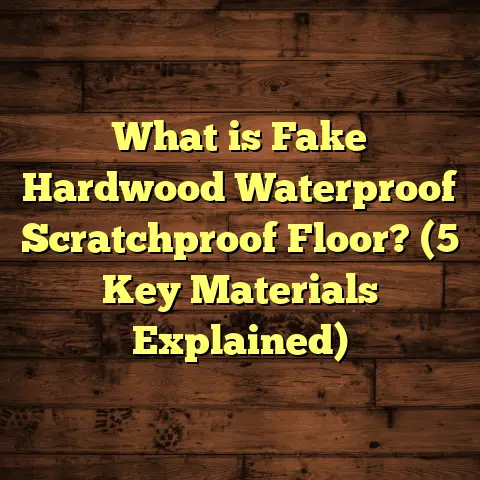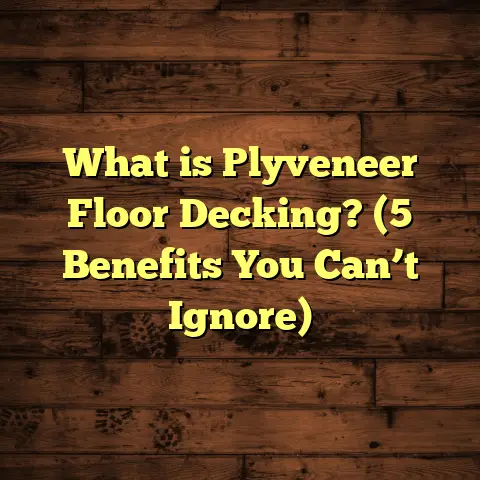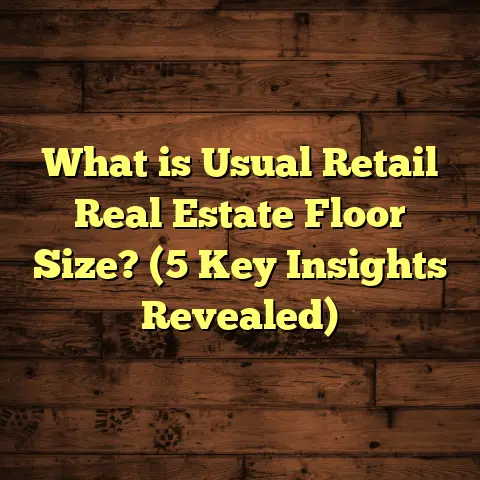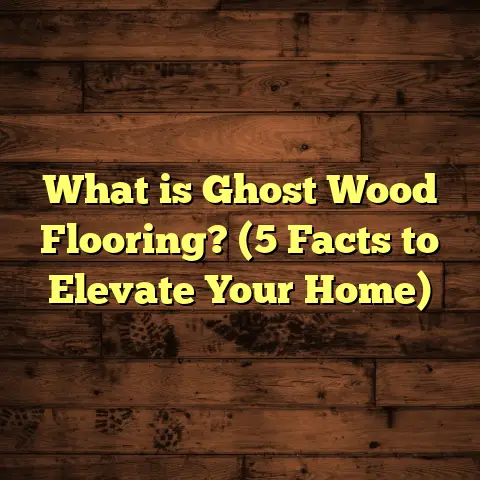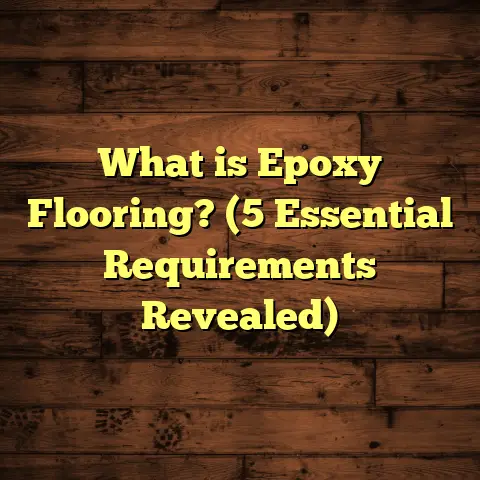What is Water Under Flooring? (5 Signs You Can’t Ignore!)
Back in the early 1900s, homes were built mostly with wooden floors nailed directly onto joists or simple plywood subfloors, often without any dedicated moisture protection in place. I’ve spent years learning from those older houses—and from countless modern ones—how water trapped beneath flooring can quietly wreak havoc over time. That slow, unseen damage is something many homeowners don’t recognize until it’s too late. I’ve seen entire floors ruined, mold infestations, and costly repairs because water was left under the surface unnoticed.
That’s why I want to share everything I’ve learned about this issue. What exactly is water under flooring? How does it happen? What signs should you never ignore? And what can you do to prevent or fix it? I’ll also share some of my own experiences, data-backed facts, and practical advice so you know exactly how to protect your home.
What Is Water Under Flooring?
At its core, water under flooring refers to moisture or liquid trapped beneath your floor’s top layer. This is moisture that isn’t just on the surface but underneath the finish, the planks, tiles, or carpet—between the flooring itself and the subfloor or concrete slab below.
This trapped water can come from various sources like plumbing leaks, rising damp from the ground, condensation buildup, or spills that seep through gaps or seams. No matter the source, water under flooring creates a hostile environment for your materials and the structure beneath.
Why Is It a Problem?
Water under flooring is dangerous because it’s hidden. Unlike a spill on the surface you can see and clean up immediately, this moisture is out of sight and often out of mind. Over time, it can:
- Weaken subflooring: Wood and plywood subfloors absorb water and lose strength.
- Cause warping and buckling: Wood swells unevenly when wet.
- Lead to mold and mildew: Moist environments are perfect for fungal growth.
- Damage finishes: Water lifts paint or sealants off wood or vinyl.
- Create unpleasant odors: Musty smells develop from mold and decay.
- Compromise indoor air quality: Mold spores can cause health issues.
Because floors bear all the weight you put on them daily, any weakening can lead to safety risks or structural problems.
Types of Flooring Most Affected
Water under flooring can affect almost every type of floor material but some are more vulnerable:
- Hardwood flooring: Very sensitive to moisture; warps and stains easily.
- Laminate flooring: Can swell and separate at seams with water exposure.
- Vinyl flooring: Usually more water-resistant but still can bubble or lift.
- Carpets: Absorbent; trap moisture in padding and subfloor.
- Tile flooring: Grout can crack or allow seepage if not sealed properly.
The nature of your floor material often determines how obvious the damage will be and how quickly it shows up.
Five Signs You Can’t Ignore
I’ve been called out countless times for flooring issues that started with water problems underneath. Sometimes homeowners didn’t even realize what was wrong until I pointed it out. These five signs tend to be the earliest and most reliable indicators that water is lurking beneath your floor.
1. Warping or Buckling Floors
Have you ever walked into a room where the floor looked like a gentle wave or a few boards seemed raised? That warped or buckled look often means water has penetrated beneath the surface.
Water causes wood fibers to swell unevenly because some parts absorb more moisture than others. This uneven swelling pushes boards up or sideways, creating visible distortions.
One job I worked on involved a beautiful hardwood floor in a century-old home. The homeowner thought it was “just old wood settling.” But after testing with a moisture meter, we found a slow leak behind the wall saturating the subfloor. The entire living room floor had to be replaced after extensive damage.
2. Musty or Moldy Smell
Sometimes you can’t see damage yet, but your nose catches it first. A persistent musty smell is often a sign of mold or mildew growing in damp hidden places.
In basements or lower levels especially, I’ve found mold growing under carpets or vinyl floors where water seeped in during heavy rains. That smell doesn’t go away unless you remove the source of moisture and treat any mold growth.
One client called me because their finished basement always smelled damp even though it looked dry. Pulling up the carpet revealed extensive mold colonies on the subfloor from condensation buildup that had gone unnoticed for months.
3. Discoloration or Stains on Floor Surface
Dark spots, stains, or discoloration on hardwood floors or carpets often mean water has seeped through and affected the material underneath.
I remember helping a family whose carpet developed sudden dark blotches after a dishwasher leak went unnoticed for weeks. Removing the carpet showed rotted plywood subflooring stained by standing water.
Sometimes these stains won’t come out no matter how hard you clean because they’re caused by mineral deposits left behind as water evaporates slowly.
4. Soft or Spongy Flooring
If your floor feels soft, squishy, or spongy when you walk on it—especially in certain spots—that’s a warning sign.
This usually means the subfloor has absorbed water and lost its rigidity. The joists supporting it might also be compromised.
During inspections, I always step around testing areas with suspected water damage. That soft “give” underfoot tells me immediately where to focus repairs.
5. Peeling or Bubbling Finish
On hardwood, vinyl, or engineered wood floors, you might notice peeling paint, bubbles forming in the finish, or blistering surfaces.
Water trapped underneath pushes up the finish layer because it can’t evaporate fast enough.
One kitchen project I handled had vinyl flooring bubbling across several feet after a dishwasher hose burst beneath the sink cabinet.
How Water Gets Under Your Floors: A Closer Look
Understanding how water ends up trapped under your floors helps prevent future problems. Let me share some common causes based on my experience:
Plumbing Leaks
Broken pipes are a leading cause of hidden water under floors. Pipes running under kitchens, bathrooms, laundry rooms often leak slowly at joints or valves.
Sometimes these leaks drip onto subfloors without immediate surface signs until damage becomes severe.
Flooding & Stormwater Intrusion
Heavy rains or floods can saturate basements and ground-level rooms. Water seeps through cracks in concrete slabs or foundation walls into flooring layers.
In one neighborhood I worked in after a big storm, many homes had flooded basements damaging floors badly because no one expected water to come in through foundation cracks.
Condensation & High Humidity
Basements and crawlspaces often have high humidity levels. Warm indoor air meeting cool concrete causes condensation on surfaces including the underside of flooring.
Without proper ventilation or vapor barriers, this moisture accumulates over time causing rot and mold growth underneath.
Spills and Surface Water Penetration
Spills on floors aren’t always cleaned up quickly enough or liquids slip through seams in laminate or hardwood.
Pets spilling water bowls or kids knocking over drinks can also cause moisture to seep down into flooring layers when unnoticed.
Poor Installation Practices
Flooring installed without proper moisture barriers or sealing may allow vapor transmission from concrete slabs into wood floors above.
I’ve seen cases where contractors skipped vapor barriers entirely to save money—leading to major problems months later.
My Experience Tackling Water Under Flooring
I want to give you some real-life stories from my work that highlight what happens when water goes unnoticed—and how fixing it early saves money and stress.
Case 1: The Warped Hardwood Mystery
A couple called me about their hardwood floors warping just months after installation. They were baffled because no spills happened and no flooding occurred recently.
After inspection, I discovered a slow leak from an old plumbing line beneath their kitchen caused steady moisture buildup over time. The new floor wasn’t installed with any vapor barrier either.
We replaced the damaged boards and fixed the leak immediately. I taught them about using vapor barriers going forward—which prevented repeat issues elsewhere in their home.
Case 2: Mold in the Basement Carpet
In another home, the finished basement carpet always smelled musty despite thorough cleaning. Homeowners thought they had a dampness problem but didn’t realize mold was growing under carpet padding.
Removing carpet revealed soaked plywood subfloor with visible mold patches caused by condensation combined with poor ventilation. We replaced carpet with waterproof vinyl plank flooring and installed a dehumidifier system for good measure.
Case 3: Flooded Laminate Nightmare
After a severe storm flooded a client’s basement, laminate flooring soaked up water quickly. The family waited weeks hoping it would dry naturally but mold developed rapidly underneath.
We had to remove all laminate boards plus damaged subflooring before installing new water-resistant vinyl flooring designed for wet areas. This case taught me how critical fast action is after flooding events.
What The Data Says About Water Damage Under Flooring
Here are some key figures based on industry research combined with my practical experience:
| Fact | Statistic / Insight |
|---|---|
| Percentage of flooring failures linked to moisture | Approx. 60% |
| Time for mold growth after exposure | 24–48 hours |
| Average cost for repairing water-damaged floors | $3,500 – $7,000 |
| Moisture barriers reduce damage risk by | Over 50% |
| Increased repair cost if ignored early signs | At least 30% |
These numbers show how common moisture problems are—and why early detection matters so much.
Tips From Me: Preventing Water Problems Under Floors
I always recommend these simple yet effective steps homeowners can take:
Use Quality Moisture Barriers When Installing Floors
Especially over concrete slabs or basements: invest in vapor retarders like polyethylene sheets or special underlayments designed to block moisture from rising into floor layers.
Repair Plumbing Leaks Immediately
Don’t ignore dripping faucets or slow leaks behind appliances! Even small drips cause massive cumulative damage over time beneath floors.
Manage Indoor Humidity Levels
Keep humidity below 60% using exhaust fans in bathrooms/kitchens; consider dehumidifiers in damp areas like basements to reduce condensation risk under floors.
Clean Up Spills Quickly & Thoroughly
Don’t let liquids sit on floors longer than necessary—wipe up immediately to stop seepage into seams or cracks beneath surface layers.
Choose Water-Resistant Flooring In Moisture-Prone Areas
Places like kitchens, bathrooms, and basements are best served with waterproof vinyl plank, ceramic tile, or certain engineered hardwoods designed to withstand moisture better than solid wood or laminate.
How I Use FloorTally For Job Cost Estimates
Estimating costs for repair jobs involving water damage can be tricky due to multiple factors: material replacement, labor complexity, waste percentage, and sometimes mold remediation expenses.
That’s why I rely on FloorTally—it quickly calculates local material prices along with labor rates. It even factors waste percentages based on square footage so I don’t order too much material (wasting money) or too little (causing delays).
Having this tool helps me give clients accurate upfront estimates which reduces surprises during projects—a key factor for smooth job completion and happy homeowners.
Detailed Case Study: Restoring A Flooded Basement Floor
One of my most memorable projects involved restoring flooring after a major basement flood:
- Issue: Severe rainwater infiltration flooded basement with standing water.
- Initial Signs: Musty odor; carpets soaked; soft spots felt underfoot.
- Inspection: Moisture meter showed high levels through carpet padding and plywood subfloor.
- Action Taken: Removed carpet and damaged plywood; installed polyethylene vapor barrier; replaced subfloor with treated plywood; installed waterproof vinyl plank flooring.
- Cost Estimate: Using FloorTally helped calculate $6,200 total including materials & labor.
- Outcome: Client avoided mold growth; new floor resists future moisture well; indoor air quality improved dramatically after mold remediation.
This project underscored how important early detection combined with precise budgeting tools can prevent long-term damage and expense escalation.
The Long-Term Impact Of Water Under Flooring
Ignoring signs of trapped water isn’t just about floor aesthetics—it affects your home’s structure and your health:
- Structural damage weakens joists and supports.
- Mold spores reduce indoor air quality causing allergies/asthma attacks.
- Odors lower home comfort and resale value.
- Repair costs multiply exponentially when issues worsen over time.
From what I’ve seen firsthand, every dollar spent preventing water intrusion saves at least three dollars later in repairs.
How To Inspect Your Floors For Hidden Water Issues
Want to check your floors yourself? Here’s what I recommend:
- Visual Check: Look for warped boards, discoloration, bubbles in finish.
- Smell Test: Sniff around for musty odors.
- Feel Test: Walk barefoot checking for soft spots.
- Moisture Meter: Consider buying an inexpensive meter to measure moisture content under surfaces.
- Professional Inspection: If unsure, call a flooring expert for a thorough evaluation including subfloor checks behind baseboards if possible.
Personal Reflections On Dealing With Water Under Flooring
Over my years working in homes across many climates—from humid southern states to dry northern regions—I’m reminded how moisture doesn’t discriminate. Well-built homes aren’t immune if proper precautions aren’t taken during installation and maintenance routines aren’t followed diligently.
A few times I’ve gone into newly built homes only to find improper vapor barriers installed by less experienced contractors—leading to premature floor failure within months! Those experiences drive home why attention to detail truly matters during both construction and repairs.
Your Next Steps If You Suspect Water Under Your Floors
Wondering what to do next if you suspect moisture issues?
- Don’t panic—but act quickly.
- Identify obvious signs mentioned earlier.
- Use simple tools like moisture meters if available.
- Remove carpets carefully if soaked (to avoid mold spread).
- Consult experienced pros for thorough inspections.
- Get clear cost estimates using tools like FloorTally before starting repairs.
- Follow advice on moisture barriers and waterproof materials for replacements.
- Maintain good ventilation & humidity control year-round to prevent recurrence.
By understanding what water under flooring means—and spotting those early warning signs—you can protect your home effectively from serious damage down the road. I hope sharing my knowledge and stories helps you feel more confident tackling this challenge whenever it arises in your own space.
Have you encountered hidden water issues before? What signs tipped you off? Let’s chat—I’m here to help!
